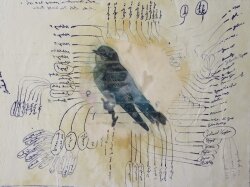Material evidence: Dass investigates the possibilities
During the Virginia Arts of Book’s recent “Raucous Auction” (mark your calendar for next year), a Dean Dass print came on the block. Someone unfamiliar with Dass’ work asked a group of us, “Would you recognize a Dean Dass piece if you just saw it somewhere?” In unison, we said, “Yes!”
As soon as the word left my mouth, though, I began pondering what distinguishes Dass’ aesthetic. I continued to mull that question while viewing Second Street Gallery’s current Dass retrospective, “Studies for a Project that cannot be Realized 1986-2011.” Arranged by palette and content rather than chronologically, the extensive show includes printmaking, drawing, painting, collage, photography, and sculpture.
Media divisions are meaningless, however, when it comes to Dass. His abstract compositions often combine etching, pencil, paints, pigments, and pasted-in bits of mica and other elements. A “print,” such as one from his 1993-1994 “Excerpt from Alexander and Roxanne” series, may result from three or more printmaking techniques mixed with other mark-making interventions. One of Dass’ defining characteristics: an open-ended willingness to experiment with materials simply to see what will happen.
In fact, research lies at the heart of the UVA art prof's overall project. Even as he probes different methods of making, his pieces’ content, though abstract, often speaks to scientific and academic investigation, with allusions to geology, astronomy, archeology, and ornithology. His compositions frequently contain what seem to be tables, diagrams, maps, and notes, or sometimes collections of specimens, all of which intentionally elude the viewer’s grasp. In this way, Dass pays homage to both the aesthetics of codified information and the inevitable failure of such attempts to describe the world.
The 2006 work, “Bluebird,” for example, features an Audubon-like illustration of a bird, fading and diffuse in a paper-wrinkling pool of watery peach and pink, surrounded by penned-in notes and sub-notes, all written backwards. The piece, though, carefully constructed, has a “found” feeling, which is another trait of Dass’ work: purposeful corrosion that mimics a sense of salvage.
Departing from his usual two-dimensional explorations, “Table Sculpture,” an ongoing 16-year project, combines this appreciation for the visual quality of excavated history with Dass' fondness for ovoid shapes. Sculpted tools of wood and bone, their purposes unknown, are laid out alongside wooden eggs, featuring circular inlays, as if relics from an archeological dig.
Dass’ work is ever changing, but his love of investigation, both artistic and academic, is ongoing.
~
Dean Dass’ retrospective exhibition, “Studies for a Project that cannot be Realized 1986-2011, is on view through December 23 at Second Street Gallery, 115 Second St. SE. 977-7284. In addition, his latest work is on view in the show, “Heaven and Earth: New Paintings and Prints,” at Les Yeux du Monde, 841 Wolf Trap Road. 973-5566.
